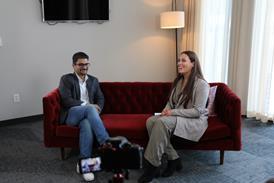.jpg)
News last week that the rescue package for the Detroit Big Three had fallen through led some to speculate that Chapter 11 proceedings before Christmas could be a reality for Chrysler, GM or Ford. Before the deal fell through, Chrysler’s logistics team in North America told Automotive Logistics that the company’s supply chain is being re-worked to cut costs and help the company to weather the storm engulfing the global car industry.
Peter Weiss, Director, Worldwide Transportation and Customs, said that Chrysler’s main objective is to operate a transparent supply chain that is low cost and a highly flexible. Flexibility is key – Weiss pointed out that the company must be able to adjust its transport network to account for changes in its production levels.
In addition to the difficult market conditions, Chrysler, like other vehicle manufacturers, is coming under pressure to reduce its carbon footprint. While efforts to reduce fuel emissions in North America have not matched those in Europe, North America‘s transport sector is beginning to make some serious efforts to improve the environment. For example, the SmartWay Transport Partnership is collaborative effort between the freight industry and the US Environmental Protection Agency, whose purpose is to protect the environment and reduce fuel consumption.
For Chrysler, the key objective right now is to achieve a high level of fuel economy. Weiss said that although it has not yet reached its goal, Chrysler wants to become the first SmartWay carrier that belongs to a major vehicle manufacturer – Chrysler Transport has one of the youngest fleets in place, which means that its trucks are more likely to meet or exceed stricter environmental standards. Chrysler is also striving to become a SmartWay shipper, which requires it to document its entire carrier base and to promote fuel efficiency. “We are looking at transportation costs and the environmental impact of transportation from a global perspective. If Chrysler sources a part from overseas that offers a lower total cost than a closer supplier does, then that is the one that we would use,” said Weiss. He argued that shipping across the Pacific Ocean could yield lower emissions than could a truckload from the US South to the Midwest.
The carmaker is also trying to avoid empty and wasted miles by working with other OEMs and carriers throughout North America. On the finished vehicle side, Chrysler is utilising per-VIN pricing and triangulation with carriers. “Chrysler can now balance more loads than in the past,” said Weiss. “Previously, with most of the production in the Midwest, we could not achieve balanced flows. Now, we can balance the flows to and from the Midwest with vehicle imports. Likewise, in delivering vehicles to the South, we can coordinate return shipments.” For example, Chrysler uses rail to transport vehicles to Texas where the carrier can pick up return loads.
Chrysler is also making a group effort through a new organisation called the Logistics Advisory Council, which includes Chrysler and its key suppliers. The organisation’s charter will include making recommendations to improve logistics efficiency. For example, Chrysler’s Regional Inbound Logistics Centres (RILC) could suggest different delivery window times for truckload carriers, which would reduce overall transit time and labour usage.
For the full interview with Weiss and the Chrysler team, read the lead story in the January-March 09 edition of Automotive Logistics magazine online or out later this week in print.




























